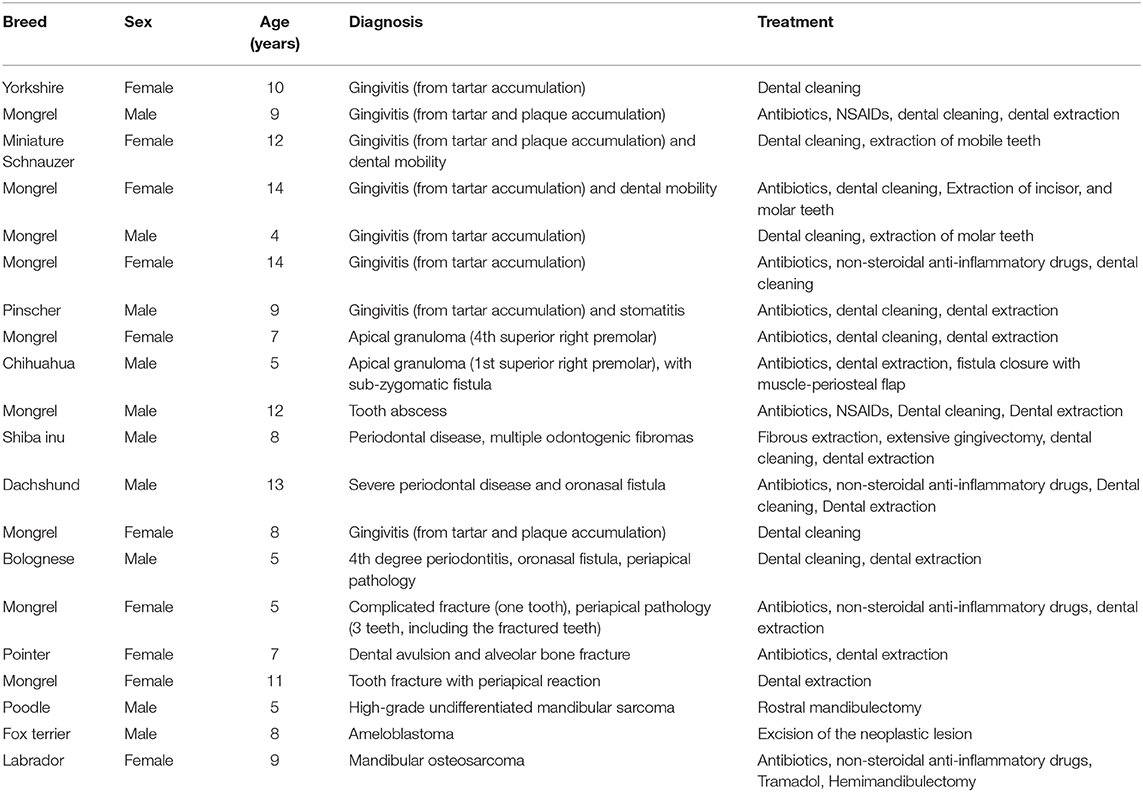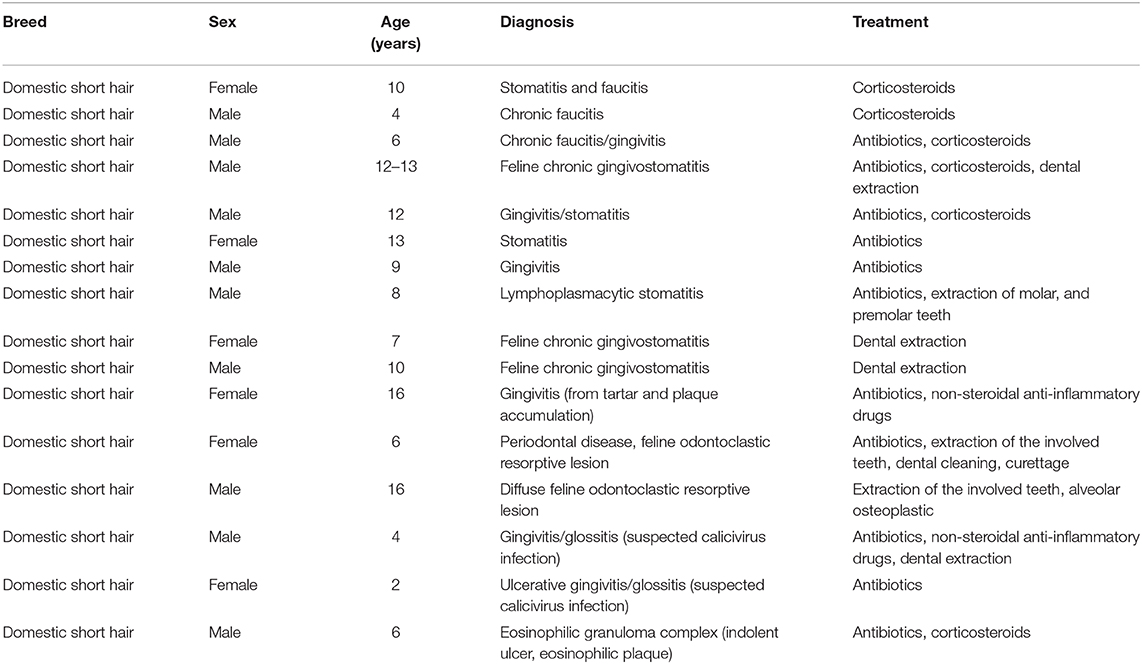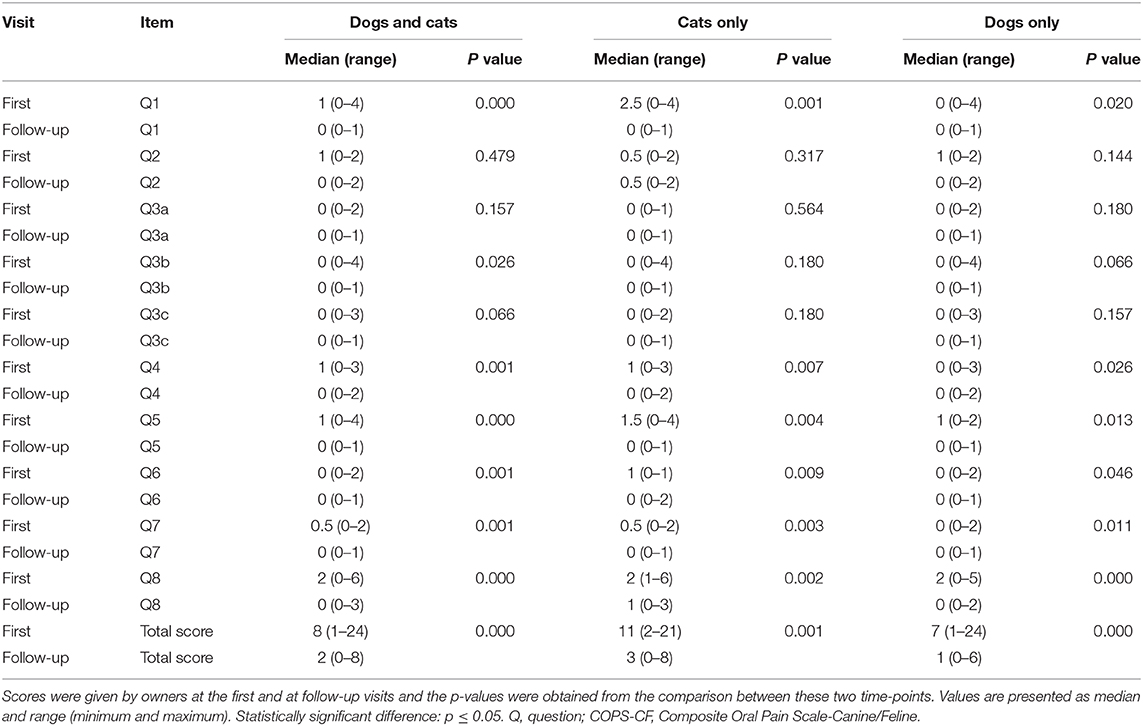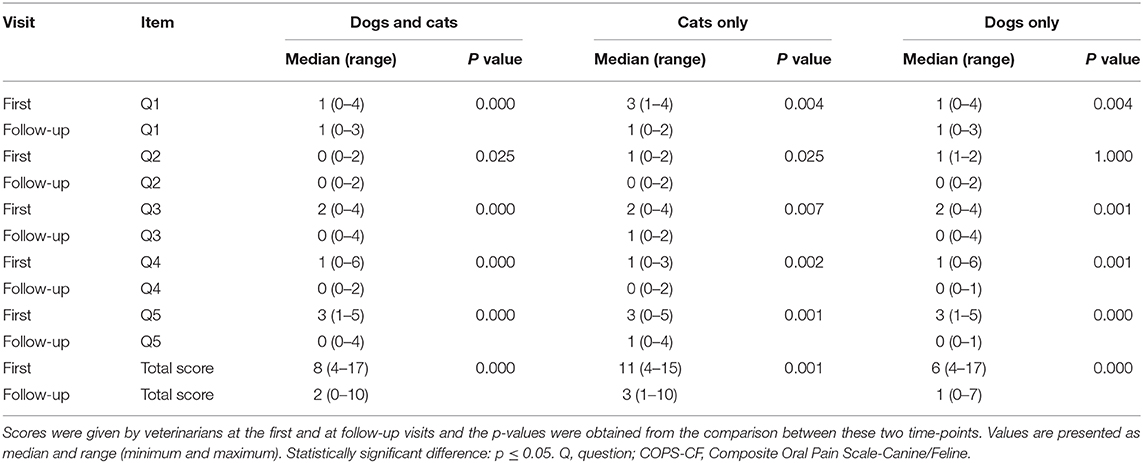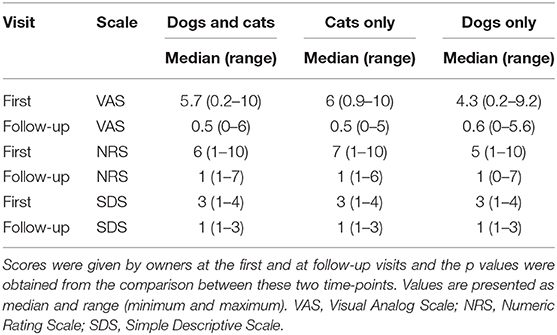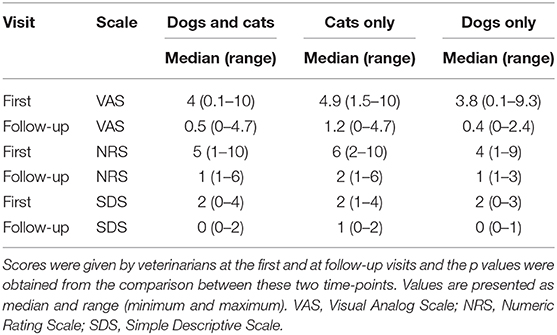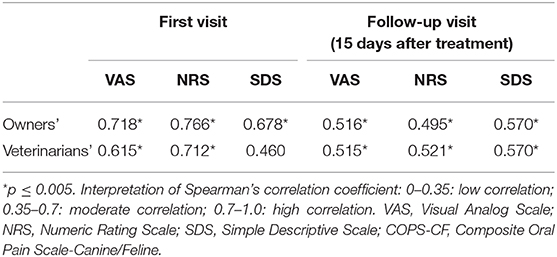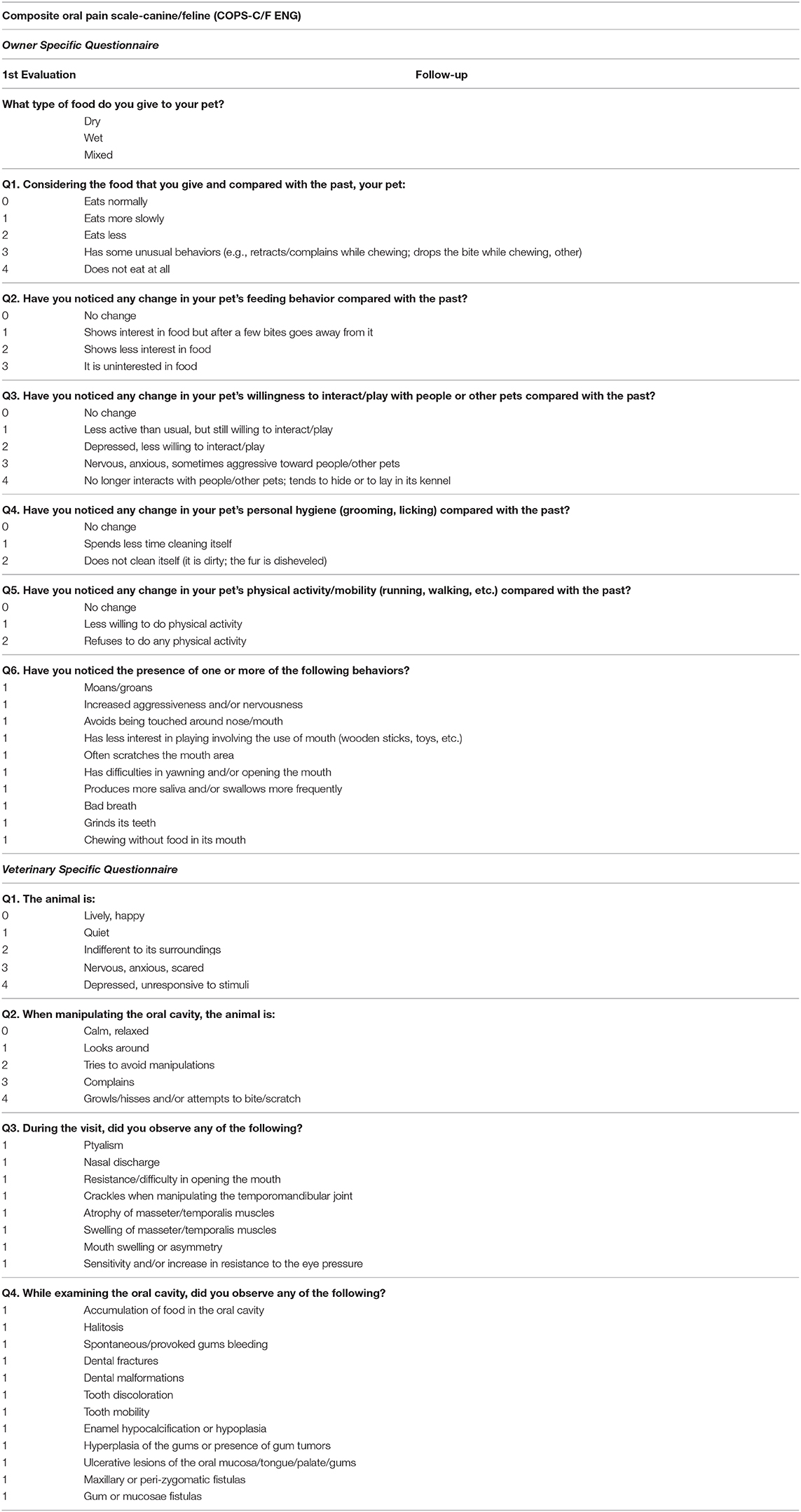- 1Department of Veterinary Medicine, University of Perugia, Perugia, Italy
- 2Department of Veterinary Medicine, CeRiDA (Centro di Ricerca sul Dolore Animale), University of Perugia, Perugia, Italy
- 3Department of Clinical Sciences, Faculty of Veterinary Medicine, University of Montreal, Saint-Hyacinthe, QC, Canada
Objectives: Oral pain is underrecognized and undertreated in small animal practice. This study aimed to develop and perform a preliminary validation of an instrument to evaluate oral and maxillofacial pain in dogs and cats.
Methods: Indicators potentially associated with oral pain in dogs and cats were identified and selected. The Composite Oral Pain Scale-Canine/Feline (COPS-C/F) in the Italian language was developed using a two-part questionnaire (owner and veterinary specific questionnaires). The instrument was used to score the intensity of oral and maxillofacial pain in patients with oral disease. Content validity was performed and the COPS-C/F was applied to 20 dogs and 16 cats with oral disease at baseline and 15 days after dental treatment for construct validity. Criterion validity was assessed by comparing the COPS-C/F with a visual analog scale (VAS), a numeric rating scale (NRS), and a simple descriptive scale (SDS). Construct validity/responsiveness and criterion validity were assessed with Wilcoxon and Spearman Pearson tests, respectively (p ≤ 0.05). The Cronbach's alpha coefficient was used to calculate internal consistency. Thereafter, the instrument was refined and translated to English and back-translated for semantic equivalence.
Results: Construct validity was confirmed with a significant reduction of pain scores after treatment (p < 0.05) for most items. Criterion validity was confirmed by a significant correlation among the COPS-C/F total pain scores and those from VAS, NRS, and SDS (p < 0.05). Cronbach's alpha coefficient was 0.876 and 0.860 for the owner and the veterinary specific questionnaires, respectively, indicating good internal consistency. The items that did not present significant differences between time-points and the VAS, NRS, and SDS were removed prior to translation to English (COPS-C/F ENG).
Conclusions and Clinical Relevance: The study described the development and preliminary validation of the COPS-C/F as an instrument for pain assessment in dogs and cats. Refinement and back-translation of COPS-C/F with semantic equivalency resulted in the COPS-C/F ENG consisting of six and four items for the owner and veterinary specific questionnaires, respectively. The English version requires further validation and testing using a larger number of patients in the clinical setting.
Introduction
Oral disease is one of the most common conditions in small animal practice (1). Oral and maxillofacial disorders that have been reported in the literature include gingivitis, periodontitis, feline odontoclastic resorptive lesions, ulcerative stomatitis, eosinophilic granuloma, oral tumors, palate cleft defects, lesions produced by dermatological conditions, abscesses, fractures, among others (2–5). These conditions have the capacity to induce oral pain and inflammation which may subsequently impact the patient's quality of life, nutritional status, and welfare (6). Veterinarians consider oral and maxillofacial disorders as an important cause of chronic pain in dogs (7), however studies on the subject are lacking and have mostly involved the use of local anesthetic techniques to reduce anesthetic requirements and provide perioperative analgesia in small animals (5, 8).
Pain scales or scoring systems can be used for assessment of acute and chronic pain in clinical practice. These tools including questionnaires may provide a cut-off score where interventional (rescue) analgesia is required and are used by veterinarians/owners for pain assessment in dogs (9–11) and cats (12–14). They involve a dynamic and interactive approach including observation of specific behaviors, palpation of the painful area, and subjective assessment of posture/position, among other subjective behavioral assessments. It is unknown how these instruments would “perform” in pain assessment of specific conditions such as oral pain, especially because signs of oral and maxillofacial pain have not been well-described and are not specifically included in these instruments.
Recognition and assessment of oral pain could allow early diagnosis and thus timely treatment of oral disease. A practical scoring system involving patient's assessment by both the owner and the veterinarian would provide valuable and thorough information on pain levels produced by oral conditions. Indeed, oral disease can be chronic in nature and might impact patient's health and behavior. In this context, this tool would have to go through validation for the assessment of its content, construct and criterion validity, responsiveness and reliability (15, 16).
The aim of this study was to develop and perform a preliminary validation of an instrument in the Italian language to evaluate oral and maxillofacial pain in dogs and cats, the Composite Oral Pain Scale-Canine/Feline (COPS-C/F). The hypothesis was that medical or surgical treatment of oral disease would reduce pain scores using the COPS-C/F at the follow-up visit when compared with scores upon presentation. Based on the results of preliminary validation, the instrument was refined and an English version of the scale is reported herein for future studies.
Materials and Methods
This study was approved by the Bioethical Committee of the University of Perugia (protocol number 2017/25).
Identification and Selection of Indicators of Oral Painful Conditions
The development of COPS-C/F was based on a literature search of review and original articles, and textbooks of oral disease and pathology that described clinical signs that could be related to oral pain (2–4, 6). Other indicators that could be indicative of oral pain based on clinical experience were also considered.
Descriptive Levels and Attribution of Scores
The selected indicators were categorized in various descriptive levels (i.e., categories or sections) including a specific question for each level. Each indicator was then assigned an ordinal value (0–4). The items were assembled, and the first draft of the COPS-C/F in the Italian language was produced in a two-part questionnaire format, including separate questions for the pet owner and the veterinarian, respectively. This version was drafted by two authors (GP and GdR).
Content Validity—Analysis by Experts
Content validity refers to the degree and adequacy with which the instrument actually measures the phenomenon of interest, in this case the pain (16, 17). It can be established based on the opinion of a committee of experts in the target field (16). Two veterinarians board-certified in veterinary dentistry and who were not involved in instrument development performed content (face) validity. These individuals performed an evaluation of the content and comprehensibility of each item and assigned whether the questions were relevant/important or not based on their experience. Procedures were described in lay-language when appropriate.
COPS-C/F Prototype
The prototype version of COPS-C/F was composed of 13 items in the Italian language (Supplementary Material). Eight items were included in the owner specific questionnaire and were as follows: (1) feeding behavior according to food type (dry, wet, and mixed); (2) feeding behavior following changes in feeding (from dry to wet food); (3) feeding behavior according to food temperature which was subdivided into warm (3a), cold (3b), and room temperature (3c); (4) changes in feeding behavior compared with past experience; (5) changes in willingness to interact with other pets/people compared with past experience; (6) changes in grooming compared with past experience; (7) changes in activity/mobility compared with past experience; (8) presence of specific behaviors. Five items were included in the veterinary specific questionnaire and were as follows: (1) general evaluation; (2) nutritional status and muscle tone; (3) reaction to oral manipulation; (4) presence of specific signs during physical examination; (5) presence of specific signs during examination of oral cavity. In both parts of the COPS-C/F, a Visual Analog Scale (VAS) (18), a Numeric Rating Scale (NRS) (19), and a Simple Descriptive Scale (SDS) (20) were added as part of pain assessment to test the criterion validity of the instrument. The VAS consisted of a horizontal 10-cm line where “0” corresponded to “no pain” and “10” corresponded to the “worst imaginable pain” (18). The observer would place a mark on this line based on the level of pain he/she believed the animal was experiencing in which a continuous range of values was possible. The NRS is similar to the VAS, except that the horizontal line was numbered from 0 to 10; thus, only whole numbered values were possible (19). The SDS consisted of four degrees of pain intensity: absent, mild, moderate, severe where a value from 0 to 3 was assigned to each level, respectively. The observer would choose the most appropriate degree of pain intensity he/she believed the animal was experiencing (20).
Pain scores of the COPS-C/F ranged from 0 to 39 and from 0 to 30 for the owner and veterinary specific questionnaire, respectively.
Clinical Application of COPS-C/F
Between June and September 2015 nine independent veterinarians recruited dogs and cats with oral conditions of different origin and severity (inclusion criteria). Each veterinarian enrolled from one to four dogs and from none to three cats. Animals were included in the study after obtaining owners' written informed consent. The owner was required to be available for a follow-up visit 15 days later. The presence of evident painful conditions other than the oral pathology represented the exclusion criterion used in the study.
Instructions about the inclusion and exclusion criteria and the timing of completion of the COPS-C/F were provided to veterinarians. After the initial consultation and physical examination, the instrument was completed by the owner and veterinarian.
A follow-up visit was scheduled exactly 15 days after the surgical treatment or beginning of the medical treatment, at which time the scale was once again completed for each patient by the owner and veterinarian.
Construct Validity by Hypotheses Testing (Responsiveness)
Construct validity examines whether the instrument detects changes in the construct theoretically conjectured, which provides the strongest evidence for validation (21). Construct was defined herein as “presence of oral and maxillofacial pain.” One approach to assess construct validity is by means of responsiveness. It assesses the ability of the scale to detect a significant change in scores in an expected direction in responses to a predicted event that either increase or decrease scores (22). Thus, construct validity was verified by hypothesis testing assuming that medical or surgical treatment of the oral disease would reduce pain scores at the follow-up visit when compared with scores at presentation. Pain scores for each item and COPS-C/F total scores between the first and follow-up visit were thus compared.
Criterion Validity by Comparison With Subjective Pain Scoring Systems
Criterion validity establishes the validity of a measuring instrument by comparing it with some external criterion which is usually considered a “gold-standard” (23). In the absence of a “gold-standard” measure to assess oral and maxillofacial pain in dogs and cats, criterion validity was assessed in comparison with three subjective pain scoring systems. Thus, it was determined by calculating the correlation among total scores of the COPS-C/F and scores obtained with VAS, NRS, and SDS (for owner and veterinarian separately).
Internal Consistency
Internal consistency evaluates the correlation between different items of the same instrument. It measures whether several items that propose to measure the same general construct produce similar scores (16). Internal consistency of the COPS-C/F was thus evaluated.
Statistical Analysis
Construct and criterion validity were assessed using the Wilcoxon test and the Spearman's rank correlation test, respectively; a statistically significant difference or correlation was considered when p ≤ 0.05. Internal consistency was evaluated using the Cronbach's alpha coefficient (24); values > 0.7 were considered acceptable (25).
Statistical analysis was carried out using a commercial software (SPSS, Statistics 24, IBM, Casalecchio di Reno, BO, Italy). All tests were performed analyzing data together and separately for dogs and cats.
Refinement and English Translation of COPS-C/F
Based on the results of the validation process, refinement of the COPS-C/F was performed by removing items that did not show significant differences.
Then, the prototype instrument was translated from Italian to English by one of the authors (GdR) and reviewed by two individuals who were not involved in the development of COPS-C/F (BM and PS). The instrument was subsequently back-translated to Italian by another individual fluent in both Italian and English. The original instrument and the back-translated version in Italian were compared and minor adjustments were made in the English version (COPS-C/F ENG) to maintain semantic equivalence (26, 27).
Results
Questionnaires were collected in 44 cases. Eight questionnaires were discarded due to missing data. Thirty-six questionnaires (20 dogs and 16 cats) were completed for both visits (first and follow-up visits).
Detailed demographic data, diagnosis and treatment received are presented in Tables 1, 2 for dogs and cats, respectively. In brief, dogs (different breeds, 11 females and 9 males, aged between 4 and 14 years old) were presented with gingivitis (n = 8), dental abscess (n = 1), dental fracture (n = 2) or avulsion (n = 1), periodontal disease (n = 3), apical granuloma (n = 2) and oral tumors (n = 3). Cats (all domestic short-hair, six females and 10 males, aged between 2 and 16 years old) were presented with stomatitis/faucitis/gingivostomatitis (n = 13), eosinophilic granuloma complex (n = 1), periodontal disease/feline odontoclastic resorptive lesions (n = 2). All dogs and seven cats underwent surgery including dental cleaning and/or dental extraction combined or not with medical treatment. Eleven dogs and 13 cats received medical treatment including the administration of antibiotics, corticosteroids and/or non-steroidal anti-inflammatory drugs as deemed necessary. None of the animals was treated with analgesics at the time of follow-up examination.
Construct Validity by Hypotheses Testing (Responsiveness)
COPS-C/F pain scores obtained for each item of the scale were significantly decreased at follow-up visit when compared with the first visit in six out of eight items in the owner specific questionnaire, and in five out of five items of the veterinary specific questionnaire when data for dogs and cats were analyzed together (p < 0.05), hence supporting construct validity (responsiveness) of the instrument. “Feeding behavior following changes in feeding (from dry to wet food)” and “feeding behavior according to food temperature” were not significantly different between the two visits.
Similar results were observed when data for cats and dogs were analyzed separately. However, the item “nutritional status and muscle tone” in the veterinary specific questionnaire did not show any significant difference between the first and follow-up visits in dogs.
Total scores obtained by the sum of all items' scores (owner and veterinary specific questionnaire) were also significantly decreased at follow-up visit when compared with first visit when data were evaluated for both species together [owner's median scores: 8 (first visit) and 2 (follow-up); veterinarian's median scores: 8 (first visit) and 2 (follow-up)] or separately [owner's median scores for cats: 11 (first visit) and 3 (follow-up); owner's median scores for dogs: 7 (first visit) and 1 (follow-up); veterinarian's median scores for cats: 11 (first visit) and 3 (follow-up); veterinarian's median scores for dogs: 6 (first visit) and 1 (follow-up)].
Tables 3, 4 show median and range (minimum and maximum) scores of each item of the scale and total scores recorded by owners and veterinarians, respectively.
Criterion Validity by Comparison With Three Subjective Pain Scoring Systems
Tables 5, 6 show the owners' and veterinarians' scores for VAS, NRS, and SDS, respectively. There was a significant (from moderate to high) correlation between total COPS-C/F scores and VAS, NRS, and SDS scores given by owners and veterinarians both at the first and follow-up visits, hence supporting criterion validity (Table 7).
Internal Consistency
The Cronbach's alpha coefficient for the scale's total score was 0.876 and 0.860 for the owner and the veterinary specific questionnaire, respectively, indicating good internal consistency.
Refinement and English Translation of COPS-C/F
The items that did not show significant differences between time-points (i.e., “feeding behavior following changes in feeding—from dry to wet food” and “feeding behavior according to food temperature” from the owner specific questionnaire and “nutritional status and muscle tone” from the veterinary specific questionnaire) were removed from the COPS-C/F prior to translation and back-translation. The VAS, NRS, and SDS scores were also removed since they had only been included to test the criterion validity of the COPS-C/F.
The final COPS-C/F ENG is shown in Table 8.
Discussion
Oral and maxillofacial disorders can be painful and result in chronic suffering if left untreated. Thus, appropriate recognition of oral pain is essential for timely treatment of these conditions (6). This study presented the development, preliminary validation and refinement of an instrument to evaluate oral painful conditions in dogs and cats by owners and veterinarians.
Validation of health measurement scales should ensure that the instrument measures what it is intended to measure and includes content, construct and criterion validity (12). After content validity, the majority of items in the prototype (Italian) version of COPS-C/F showed appropriate construct and criterion validity, and good internal consistency.
Construct validity refers to the degree to which a score can be interpreted as representing the intended underlying construct. In other words, it refers to the extent to which a measure assesses the construct of interest (15, 25). In this study, construct was defined as “presence of oral and maxillofacial pain.” Construct validity can be assessed by different approaches. One approach refers to the ability of the instrument to detect differences between groups or, in this case, to distinguish between painful and non-painful individuals. Thus, animals in a control group (non-painful) would have significantly lower pain scores than painful ones. The lack of a control group is an important limitation and a source of intrinsic bias in this study. Another approach for assessing construct validity is to test the responsiveness of the scale (i.e., treatment effect). Thus, pain scores in painful animals would decrease after treatment (15). In this study, the COPS-C/F showed appropriate responsiveness to medical or surgical treatment of oral disease since pain scores were decreased at the follow-up visit when compared with the first presentation. However, a placebo effect may have been observed since owners and veterinarians where aware that animals were being treated (i.e., observer bias). Indeed, veterinarians completing the COPS-C/F were the ones performing or prescribing treatment and reevaluating these animals. This represents another significant limitation of this study. Future studies should minimize bias by including a control group of non-painful animals and by including independent observers who are blinded to disease severity and/or treatment. On the other hand, the scale showed promising results despite having nine different veterinarians evaluating a small number of patients each. This could be considered a strength of the study although it certainly added variability to the data.
Criterion validity was observed with the significant correlation between COPS-C/F total score (dogs and cats together) and subjective pain scoring systems (VAS, NRS, and SDS) at first and follow-up visits. It is arguable that criterion validity should be performed against a “gold-standard” instrument that has been validated for the same purposes. However, the prototype instrument was developed in the Italian language and similar instruments for assessment were not available in the same language until recently (28). In addition, there is currently no “gold-standard” available for assessment of oral and maxillofacial pain. In the absence of such instrument, it was decided to use subjective pain scoring systems such as the VAS, SDS and NRS for comparison because they can be easily applied to owners.
The reliability testing of an instrument involves internal consistency, intra-rater and inter-rater testing (12). Preliminary validation of COPS-C/F showed good internal consistency. Further studies involving video or real-time pain assessment of the same patient by different raters may allow the evaluation of inter-rater reliability, or the ability of the instrument to produce similar results when used by different individuals (12). Similarly, intra-rater reliability could be performed using video-assessment when the same individual (rater) evaluates the same patient at different times to test the ability of the instrument to produce similar results when used by the same individual (12).
A particular advantage of the COPS-C/F over previous instruments for pain assessment is that veterinarians and/or owners can complete the evaluation of pain in an animal with a specific condition (i.e., oral disease). However, the discriminatory ability of this instrument has not been investigated and it is not possible to differentiate pain intensity (mild, moderate, and severe) or painful vs. non-painful individuals. The ability of COPS-C/F to be used as a monitoring tool in the clinical setting and to identify “treatment failure” requires further evaluation to ensure that the instrument is practical, user-friendly and easy to implement independently of the observer (owner or veterinarian) or origin and type of pain (e.g., medical or surgical). Moreover, the identification of a cut-off for interventional (rescue) analgesia (sensitivity testing) should be the subject of future studies.
The COPS-C/F ENG can now undergo further validation and testing in clinical trials using a larger number of patients, thus providing veterinarians with a potential scale for canine and feline oral pain assessment. Further content validity, construct validity, criterion validity using another validated instrument (e.g., the Glasgow canine or feline pain scale), inter- and intra-rater reliability, responsiveness including a control group and sensitivity (discriminatory ability) testing of COPS-C/F ENG are warranted.
Data Availability
The datasets generated for this study are available on request to the corresponding author.
Ethics Statement
This study was approved by the Bioethical Committee of the University of Perugia (protocol number 2017/25). The owners signed a written informed consent.
Author Contributions
GR participated in the conceptualization of the study, coordinated the clinical phase, and drafted the manuscript. AS assisted in revising the final manuscript. MM performed the statistical analysis. EB participated in the study design and supervised the clinical phase. GP participated in the distribution and returning of the questionnaires and data collection. BM and PS participated in the refinement of the COPS-C/F and manuscript drafting and editing. All authors read and approved the final manuscript.
Conflict of Interest Statement
The authors declare that the research was conducted in the absence of any commercial or financial relationships that could be construed as a potential conflict of interest.
Acknowledgments
The authors would like to thank Dr. Elisa Bortolami, Langford Veterinary Services, University of Bristol, Langford (UK), for the back-translation (English to Italian) of the COPS-C/F.
Supplementary Material
The Supplementary Material for this article can be found online at: https://www.frontiersin.org/articles/10.3389/fvets.2019.00274/full#supplementary-material
Abbreviations
COPS-C/F ENG, composite oral pain scale-canine/feline English version; COPS-C/F, composite oral pain scale-canine/feline; NRS, numeric rating scale; SDS, simple descriptive scale; VAS, visual analog scale.
References
1. O'Neill DG, Church DB, McGreevy PD, Thomson PC, Brodbelt DC. Prevalence of disorders recorded in dogs attending primary-care veterinary practices in England. PLoS ONE. (2014) 9:e90501. doi: 10.1371/journal.pone.0090501
2. Niemiec BA. Oral pathology. Top Companion Anim Med. (2008) 23:59–71. doi: 10.1053/j.tcam.2008.02.002
3. Niemiec BA. Periodontal disease. Top Companion Anim Med. (2008) 23:72–80. doi: 10.1053/j.tcam.2008.02.003
4. Squarzoni P. Odontostomatologia del Cane e del Gatto. 1st ed. Milano: Poletto Editore (2003). p. 348.
5. Watanabe R, Doodnaught G, Proulx C, Auger JP, Monteiro B, Dumais Y, et al. A multidisciplinary study of pain in cats undergoing dental extractions: a prospective, blinded, clinical trial. PLoS ONE. (2019) 14:e0213195. doi: 10.1371/journal.pone.0213195
6. WSAVA Global Dental Guidelines. Available online at: https://www.wsava.org/WSAVA/media/Documents/Guidelines/Dental-Guidleines-for-endorsement_0.pdf
7. Bell A, Helm J, Reid J. Veterinarians' attitudes to chronic pain in dogs. Vet Rec. (2014) 175:428. doi: 10.1136/vr.102352
8. Aguiar J, Chebroux A, Martinez-Taboada F, Leece EA. Analgesic effects of maxillary and inferior alveolar nerve blocks in cats undergoing dental extractions. J Feline Med Surg. (2015) 17:110–6. doi: 10.1177/1098612X14533551
9. Reid J, Nolan AM, Hughes JML, Lascelles D, Pawson P, Scott EM. Development of the short- form Glasgow composite measure pain scale (CMPS-SF) and derivation of an analgesic intervention score. Anim Welf. (2007) 16:97–104. Available online at: https://www.researchgate.net/publication/40704373_Development_of_the_short-form_Glasgow_Composite_Measure_Pain_Scale_CMPS-SF_and_derivation_of_an_analgesic_intervention_score
10. Brown DC, Boston RC, Coyne JC, Farrar JT. Ability of the canine brief pain inventory to detect response to treatment in dogs with osteoarthritis. J Am Vet Med Assoc. (2008) 233:1278–83. doi: 10.2460/javma.233.8.1278
11. Hielm-Björkman AK, Rita H, Tulamo RM. Psychometric testing of the Helsinki chronic pain index by completion of a questionnaire in Finnish by owners of dogs with chronic signs of pain caused by osteoarthritis. Am J Vet Res. (2009) 70:727–34. doi: 10.2460/ajvr.70.6.727
12. Brondani JT, Mama KR, Luna SPL, Wright BD, Niyom S, Ambrosio J, et al. Validation of the English version of the UNESP-Botucatu multidimensional composite pain scale for assessing postoperative pain in cats. BMC Vet Res. (2013) 9:143. doi: 10.1186/1746–6148–9-143
13. Calvo G, Holden E, Reid J, Scott EM, Firth A, Bell A, et al. Development of a behaviour-based measurement tool with defined intervention level for assessing acute pain in cats. J Small Anim Pract. (2014) 55:622–9. doi: 10.1111/jsap.12280
14. Benito J, DePuy V, Hardie E, Zamprogno H, Thomson A, Simpson W, et al. Reliability and discriminatory testing of a client-based metrology instrument, feline musculoskeletal pain index (FMPI) for the evaluation of degenerative joint disease-associated pain in cats. Vet J. (2013) 196:368–73. doi: 10.1016/j.tvjl.2012.12.015
15. Cook DA, Beckman TJ. Current concepts in validity and reliability for psychometric instruments: theory and application. Am J Med. (2006) 119:166 e7–16. doi: 10.1016/j.amjmed.2005.10.036
16. Streiner DL, Norman GR. Health Measurement Scales: A Practical Guide to Their Development and Use. 5th ed. New York, NY: Oxford University Press (2018). 399p.
17. Crellin D, Sullivan TP, Babl FE, O'Sullivan R, Hutchinson A. Analysis of the validation of existing behavioral pain and distress scales for use in the procedural setting. Paediatr Anaesth. (2007) 17:720–33. doi: 10.1111/j.1460–9592.2007.02218.x
18. Hudson JT, Slater MR, Taylor L, Scott HM, Kerwin SC. Assessing repeatability and validity of a visual analogue scale questionnaire for use in assessing pain and lameness in dogs. Am J Vet Res. (2004) 65:1634–43. doi: 10.2460/ajvr.2004.65.1634
19. Breivik EK, Björnsson GA, Skovlund E. A comparison of pain rating scales by sampling from clinical trial data. Clin J Pain. (2000) 16:22–8. doi: 10.1097/00002508–200003000–00005
20. Firth AM, Haldane SL. Development of a scale to evaluate postoperative pain in dogs. J Am Vet Med Assoc. (1999) 214:651–9.
21. Bullock B, Tenenbein M. Validation of 2 pain scales for use in the pediatric emergency department. Pediatrics. (2002) 110:1–6. doi: 10.1542/peds.110.3.e33
22. Baeyer VC, Spagrud LJ. Systematic review of observational (behavioral) measures of pain for children and adolescents aged 3 to 18 years. Pain. (2007)127:140–50. doi: 10.1016/j.pain.2006.08.014
23. Souza FF, Silva JA. A métrica da dor (dormetria): problemas teóricos e metodológicos. Rev Dor. (2005) 6:469−513. Available online at: https://www.researchgate.net/publication/284979775_A_metrica_da_dor_dormetria_Problemas_teoricos_e_metodologicos
24. Cronbach LJ. Coefficient alpha and the internal structure of tests. Psychometrika. (1951) 16:297–333. doi: 10.1007/BF02310555
25. Jensen MP. Questionnaire validation: a brief guide for readers of the research literature. Clin J Pain. (2003)19:345–52. doi: 10.1097/00002508–200311000–00002
26. Guillemin F, Bombardier C, Beaton D. Cross-cultural adaptation of health-related quality of life measures: literature review and proposed guidelines. J Clin Epidemiol. (1993) 46:1417–32. doi: 10.1016/0895–4356(93)90142-N
27. Souza VD, Rojjanasrirat W. Translation, adaptation and validation of instruments or scales for use in cross-cultural health care research: a clear and user-friendly guideline. J Eval Clin Pract. (2011) 17:268–74. doi: 10.1111/j.1365–2753.2010.01434.x
Keywords: cat, composite oral pain scale-canine/feline, COPS-C/F, dental, dog, oral, pain, scale
Citation: della Rocca G, Di Salvo A, Marenzoni ML, Bellezza E, Pastorino G, Monteiro B and Steagall P (2019) Development, Preliminary Validation, and Refinement of the Composite Oral and Maxillofacial Pain Scale-Canine/Feline (COPS-C/F). Front. Vet. Sci. 6:274. doi: 10.3389/fvets.2019.00274
Received: 02 May 2019; Accepted: 06 August 2019;
Published: 22 August 2019.
Edited by:
Jason W. Soukup, University of Wisconsin-Madison, United StatesReviewed by:
Peter Pascoe, University of California, Davis, United StatesStephanie Goldschmidt, University of Minnesota Twin Cities, United States
Copyright © 2019 della Rocca, Di Salvo, Marenzoni, Bellezza, Pastorino, Monteiro and Steagall. This is an open-access article distributed under the terms of the Creative Commons Attribution License (CC BY). The use, distribution or reproduction in other forums is permitted, provided the original author(s) and the copyright owner(s) are credited and that the original publication in this journal is cited, in accordance with accepted academic practice. No use, distribution or reproduction is permitted which does not comply with these terms.
*Correspondence: Giorgia della Rocca, Z2lvcmdpYS5kZWxsYXJvY2NhQHVuaXBnLml0
 Giorgia della Rocca
Giorgia della Rocca Alessandra Di Salvo1,2
Alessandra Di Salvo1,2 Beatriz Monteiro
Beatriz Monteiro Paulo Steagall
Paulo Steagall